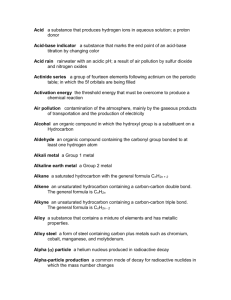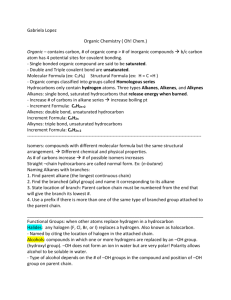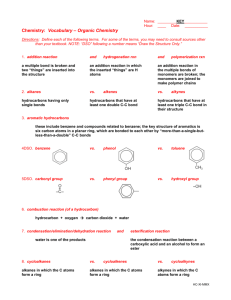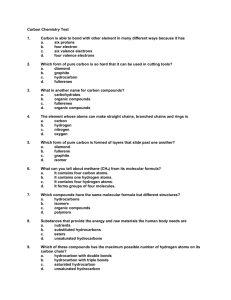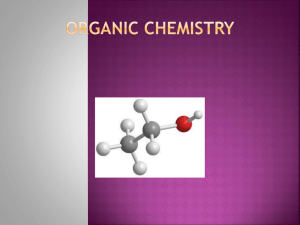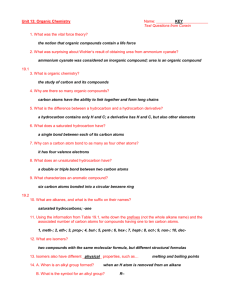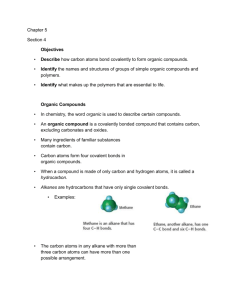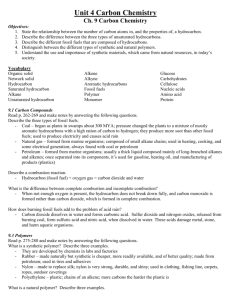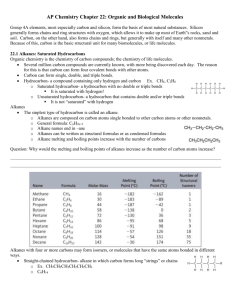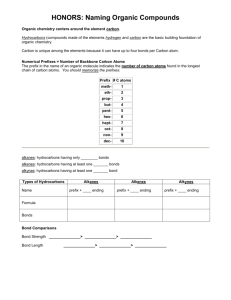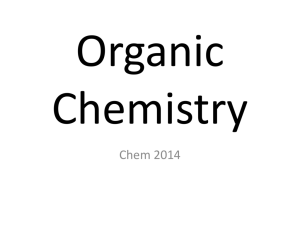File
advertisement
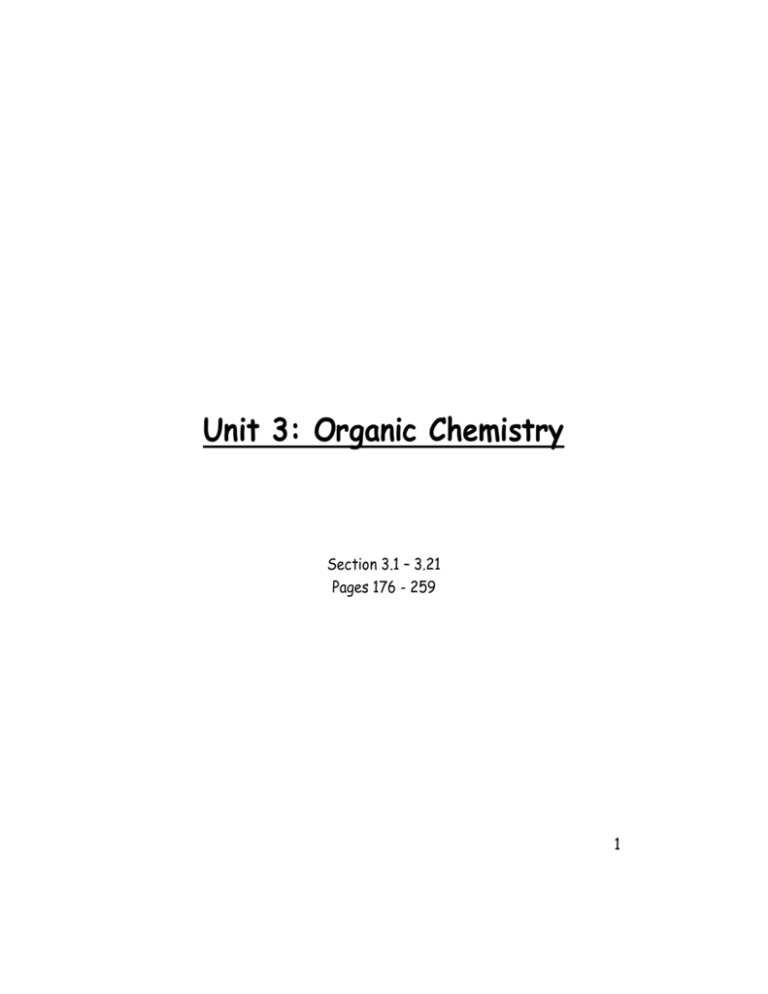
Unit 3: Organic Chemistry Section 3.1 – 3.21 Pages 176 - 259 1 3.1 Hydrocarbons 1 Term Definition An organic compound that contains only carbon and hydrogen atoms in its molecular structure. Alkane A hydrocarbon that contains at least one C=C double bond; general formula: CnH2n Alkyne 2 Hydrocarbons 2 Propane is a fuel that is commonly used in gas barbecues. Draw a structural formula for propane, and write its formula. Step 1: Write Carbon Backbone of Appropriate Length Step 2: Add single Lines to Each Carbon, to a Total of Four Lines Step 3: Fill Remaining Bonds with Hydrogen Atoms Butane Octane Methane 3 Hydrocarbons 3 Draw a structural formula and write the molecular formula for 1-hexene Step 1: Write Carbon Backbone of Appropriate Length Step 2: Establish Location of Double Bond Step 3: Fill Remaining Bonds with Hydrogen Atoms **Use the lowest number – The carbon backbone of alkenes and alkynes is not always numbered from the left. Check the location of the double or triple bond before deciding how to number the carbon atoms.** Draw a structural formula and write the molecular formula for each of the following hydrocarbons: a) ethane, b) ethyne, c) 2-hexene 4 Reactions of Hydrocarbons Complete Combustion: hydrocarbon + oxygen carbon dioxide + water Write a balanced chemical equation to represent the complete combustion of 1-hexene. Use a condensed structural formula to represent 1-hexene. Step 1: Write Word Equation for Reaction Step 2: Write Chemical Formulas Step 3: Balance Equation Term Definition A reaction of an alkene / alkyne in which a molecule, such as hydrogen or a halogen, is added to a double / triple bond Unsaturated Containing only single C-C bonds Draw a structural formula equation for each of the following addition reaction: 2-butene and water, H2O 5 Fractional Distillation & Cracking Term Definition A mixture of gases and liquids, composed of hydrocarbon molecules up to 40 C atoms long Fractional Distillation The process in which large straight-chain hydrocarbon molecules are converted into smaller branched-chain hydrocarbon molecules, usually by catalytic heating 6 Fraction Distillation & Cracking 2 7 Functional Groups Term Definition A group of organic compounds with common structural features that share chemical and physical properties Functional group An intermolecular attraction between –OH and –NH groups in different molecules 8 Alcohols & Ethers Term Definition An organic compound that is characterized by the presence of a hydroxyl functional group; general formula: R-OH Ether A substitution group or branch from a hydrocarbon; general formula: R Draw the structural formula and write the formula for 1-butanol Step 1: Draw Carbon Backbone Step 2: Add –OH Group in Appropriate Position Step 3: Complete Remaining Bonds with H atoms 9 Alcohols & Ethers 2 Properties of Alcohols Properties of Ethers Naming Ethers Name the following ether: a) CH3OCH2CH3 Step 1: Add “oxy” to the prefix of the smaller hydrocarbon Step 2: Join the new prefix to the alkane name of the larger hydrocarbon group. b) Methoxymethane c) butoxypentane 10 Aldehydes & Ketones Term Definition An organic compound in which the carbon atom of a carbonyl group is bonded to two carbon atoms Aldehyde A functional group that contains a carbon atom joined to an oxygen atom with a double covalent bond; general formula: C=O Naming Aldehydes Step 1: take the parent alkane name, drop the final –e, and add -al Naming Ketones Step 1: replace the –e ending of the parent alkane name with -one 11 Carboxylic Acids Term Definition An organic compound that is characterized by the presence of a caroxyl group; general formula: R-COOH Carboxyl group Naming Carboxylic Acids Step 1: Identify the number of atoms in the longest carbon chain Step 2: Take off the –e ending and replace with “anoic acid” 12 Esters Term Definition An organic compound that is characterized by the presence of a carbonyl group bonded to an oxygen atom Esterification A reaction in which a bond is broken by the addition of water, resulting in the formaiton of two or more products. Esterification Naming Esters The name of the ester has two parts. The first part comes from the alcohol and the second part comes from the carboxylic acid The ending of the acid name is changed from –anoic acid to –anoate 13 Esters 2 Hydroylsis 14 Amines & Amides Term Definition An organic compound in which one or more hydrogen atoms are replaced by alkyl groups Amide Naming Amines Step 1: add the prefix “amino” Step 2: identify the longest-chain hydrocarbon. Naming Amides Step 1: similar to naming esters. While esters end in –oate, amides end in -amide 15 Polymers Term Defintion A synthetic substance that can be moulded (under heat and pressure) and retains the shape it is moulded into Polymer A polymer that is formed when monomer units are linked through addition reactions; all atoms in the monomer are retained in the polymer Monomer 16 Condensation Polymers Term Definition Covalent bonds that form between polymer chains Polyester A polymer that is formed by condensation reactions resulting in amide linkages between monomers Condensation polymer 17

